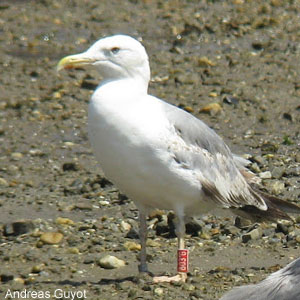Pratique | Identification
Goéland cantabrique : présentation, identification et observation en France

Goéland cantabrique (Larus michahellis lusitanius) de 3ème hiver, Ciboure (Pyrénées-Atlantiques), le 24/07/2013.
Photographie : Andreas Guyot
Introduction
La taxonomie (classification) du Goéland leucophée (Larus michahellis) est encore mal connue : en particulier, ses liens avec le Goéland argenté (L. argentatus) ne sont pas bien définis et il existe des variations au sein même de l’espèce. Par exemple, la sous-espèce appelée Goéland cantabrique (L. m. lusitanius), qui niche le long des côtes septentrionales de la péninsule ibérique, du nord du Portugal au Pays basque espagnol, est plus petite, a des pattes plus courtes, présente des différences génétiques, vocales, de structure et de plumage avec les oiseaux méditerranéens « classiques ». Ils sont toutefois très difficiles à différencier de ces derniers : heureusement, des ornithologues ont bagué des milliers de poussins dans plusieurs colonies espagnoles. Des oiseaux de tous âges peuvent être observés le long des côtes du sud-ouest de la France, et Andreas Guyot, créateur du blog « Oiseaux des Pyrénées 64 » nous conseille de visiter la ville de Ciboure (Pyrénées-Atlantiques), où un reposoir de laridés fréquenté par des Goélands cantabriques (parfois bagués) se forme le long des berges de La Nivelle.
Après une présentation de cette sous-espèce assez mal connue, nous énumérons des critères permettant de la différencier du Goéland leucophée et nous décrivons le site d’observation de Ciboure.
Abstract
The taxonomy of the Yellow-legged Gull (Larus michahellis) is still poorly understood: its relations with the Herring Gull (Larus argentatus) are not well defined and there are variations within this species. For example, the Cantábrican Yello-legged Gull (L. m. Lusitanius), which breeds along the northern coast of the Iberian Peninsula, from northern Portugal to the Spanish Basque Country, is smaller, has shorter legs and presents some genetic, vocal, structure and plumage differences with the « classic » Mediterranean Yellow-legged Gulls. However, it is very difficult to differentiate from these birds. Fortunately, some ornithologists have ringed thousands of birds in several Spanish colonies and these then are easier to identify. Dozens of birds can be observed regularly along the southwestern coasts of France. Andreas Guyot, author of the blog « Oiseaux des Pyrénées 64 », recommends to visit the small town of Ciboure (Pyrénées-Atlantiques), where a roost of gulls regularly frequented by Cantábrican Yellow-legged Gulls (sometimes ringed) can be found along the banks of the Nivelle River.
After a presentation of this still poorly known subspecies, we present some criteria to differentiate it from the Yellow-legged Gull Larus m. michahellis and we present the watching spot of Ciboure.
Poursuivez la lecture de cet article, en vous abonnant dès maintenant !
Découvrez les Archives d’Ornithomedia.com
Pour seulement 10,00 €TTC/an (ou 6,00 € les 6 mois)
Profitez de plusieurs centaines d’articles en accès illimité et sans aucun engagement.
Compléments
Contact
Andreas Guyot – Courriel : guyot.andreas@neuf.fr – Blog : http://oiseaupyrenees.blogspot.fr/
À lire aussi sur Ornithomedia.com
- Identification du Goéland pontique
- Un outil pour identifier les Laridés adultes : la « Kodak Gray Scale »
- Identifier les goélands adultes en hiver dans les dortoirs
- Définition du « jizz »
- Baguer les Goélands bruns pour comprendre leur biologie
- Le baguage couleur des limicoles dans la réserve naturelle de Moëze-Oléron
- La baie de Chingoudy
- La digiscopie
Les observations sur Ornithomedia.com
Goéland cantabrique (Larus michahellis lusitanius)
À lire sur le web
Le site web d’Alain Fossé : www.digimages.info
Ouvrages recommandés
- Le guide Ornitho de Lars Svensson, Killian Mullarney, Dan Zetterstrom et Guilhem Lesaffr
- Gulls of Europe, Asia and North America de Klaus Malling Olsen et Hans Larsson
- The Birds of the Iberian Peninsula de Eduardo de Juana (Auteur) et Ernest Garcia (Auteur)
Sources
- Alain Fossé. Goéland leucophée (Larus michahellis, Yellow-legged Gull). Digimages. www.digimages.info/goeleu/goeleu.htm
- Andreas Guyot (2013). Journée lecture des bagues de goéland, sur le reposoir de Ciboure à marée basse. Oiseaux des Pyrénées 64. Date : 23/08. http://oiseaupyrenees.blogspot.fr/2013/08/journee-lecture-des-bagues-sur-les.html
- Rui Caratão (2012). Azorean Yellow-legged Gull at Algés. Gulls in Lusitania. Date : 26/09. http://gullsinlusitania.blogspot.fr/2012_09_01_archive.html
- Juan Arizaga, Asier Aldalur, Alfredo Herrero et David Galicia (2008). Sex Differentiation of Yellow-Leged Gull (Larus michahellis lusitanius): the use of biometrics, bill morphometrics and wing tip coloration. W
Waterbirds 31(2). Pages : 211-219. www.gull-research.org/papers/papers2/Waterbirds_31%28211-219%29.pdf - Gabriel Martin (2009). Larus michahellis lusitanius 4cy. Larus. http://larusfuscus.blogspot.fr/2009_10_01_archive.html
- Gull Rsearch. lusitanius Yellow-legged Gull. http://gull-research.org/lusitanius/01cyoct.html
- Bittor Mutiozabal. Kaio hankahoria (Larus michahellis lusitanius). http://inurritzakoak.blogspot.fr/search/label/Kaio%20hankahoriak
- Asier Aldalur. Gaviota patiamarilla / Yellow legged gull / Kaio hankahoria (Larus michahellis lusitanius). Larus.eus. http://laruseus.blogspot.fr/2015/02/gaviota-patiamarilla-yellow-legged-gull.html
- C. Joiris (1978). Le Goéland argenté portugais (Larus argentatus lusitanius), nouvelle forme du Goéland argenté à pattes jaunes. Aves (15). Pages 17-18. www.aves.be/fileadmin/Aves/Bulletins/Articles/15_1/15_1_17.pdf
- José I. Aguirre, Pilar Arana et Maria Teresa Antonia (2009). Testing effctiveness of discriminant functions to sex diffrent populations of Mediterranean Yellow-legged Gulls Larus michahellis michahellis. Ardeola
56(2), 2009, 281-286. www.ardeola.org/files/1443.pdf





Aucun commentaire sur ce sujet
Participer à la discussion !